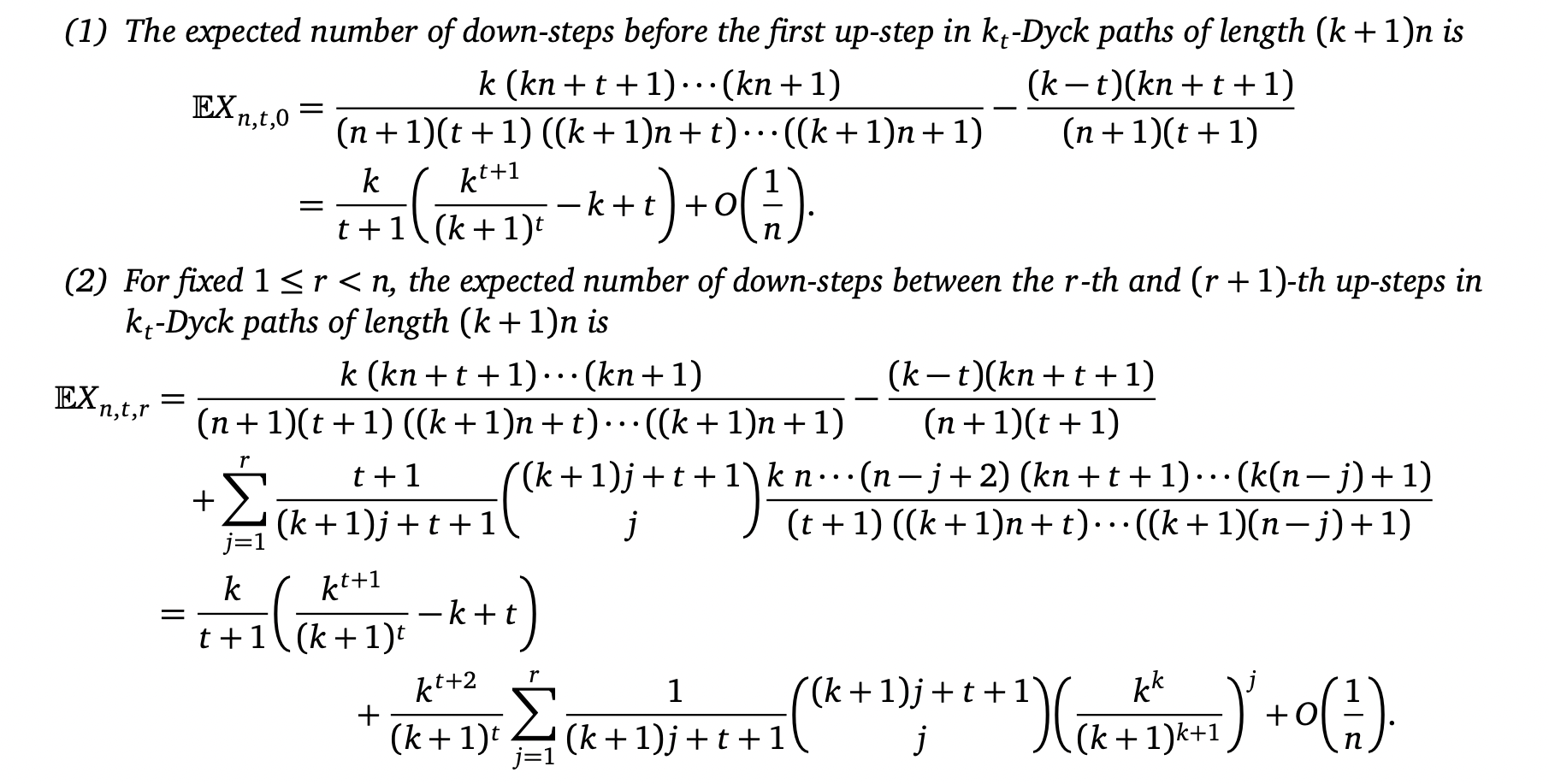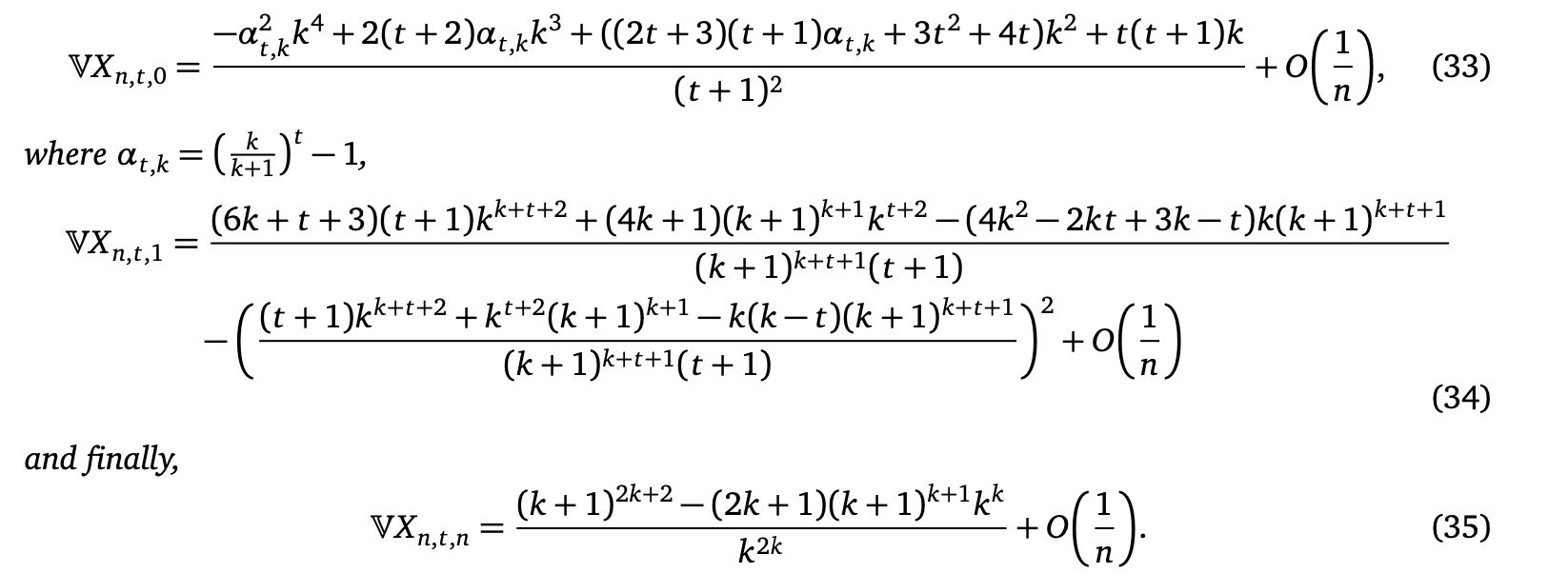Down-Steps in Generalized Dyck Paths
Benjamin Hackl • August 17, 2021
Exploring Down-Step Sequences
in Generalized Dyck Paths
Joint work with Andrei Asinowski and
Sarah J. Selkirk
 This work is licensed under a Creative Commons
Attribution-NonCommercial-ShareAlike 4.0 International
License.
This work is licensed under a Creative Commons
Attribution-NonCommercial-ShareAlike 4.0 International
License.

Motivation
Enumeration of- Step set $\{(a, b), (-1, 0), (0, -1)\}$, with $a, b\in \mathbb{Z}_{>0}$
- Start and end at $(t_x, t_y)$, stay in quarter plane
- Projections are special Dyck paths!
Observe: order of steps $(-1,0)$, $(0, -1)$ between $(a, b)$-steps can be changed, projections stay fixed- So, what can we say about down-steps in these projections?
Projected paths — $k_t$-Dyck paths
-
Step set: $\{ (1, k), (1, -1) \}$ -
Start and end on $y=0$, stay weakly above $y=-t$
Equivalent: start and end on $y=t$, stay weakly above $y=0$
- For this talk: $0\leq t\leq k$ (path structure changes for $t > k$)
Counting $k_t$-Dyck paths
For $n \geq 0$ and $0\leq t \leq k$, $k_t$-Dyck paths with $n$ up-steps (length $(k+1)n$) are enumerated by generalized Fuss–Catalan numbers \[ C_{n,t} = \frac{t+1}{(k+1)n + t + 1} \binom{(k+1)n + t + 1}{n}. \]
Enumeration is well-known, e.g., via [Mohanty, 1979]
or [Krattenthaler, 2015].
One elegant strategy: Cycle Lemma!
Counting $k_t$-Dyck paths
For any sequence of $m$ boxes and $n$ circles ($m \geq kn$), $m-kn$ cyclic shifts are $k$-dominating[all prefixes have #boxes > k #circles].
$k_t$-Dyck path enumeration proof idea: they are bijective to...
- paths with step set $\{(1, 1), (1, -k)\}$
- + starting at $(0, -(t+1))$, going to $((k+1)n+t+1, 0)$
- ... and then to $k$-dominating sequences with $kn+t+1$ boxes and $n$ circles $\rightsquigarrow \frac{m-kn}{m+n} \binom{m+n}{n} = \frac{t+1}{(k+1)n+t+1} \binom{(k+1)n+t+1}{n}$
Counting $k_t$-Dyck paths
- paths with step set $\{(1, 1), (1, -k)\}$
- + starting at $(0, -(t+1))$, going to $((k+1)n+t+1, 0)$
- ... and then to $k$-dominating sequences with $kn+t+1$ boxes and $n$ circles $\rightsquigarrow \frac{m-kn}{m+n} \binom{m+n}{n} = \frac{t+1}{(k+1)n+t+1} \binom{(k+1)n+t+1}{n}$
Counting Down-steps in $k_t$-Dyck paths
- $s_{n, t, r}$ ... total number of down-steps between $r$-th and $(r+1)$-th up-step in all $k_t$-Dyck paths of length $(k+1)n$ (= $n$ up-steps)
\[ s_{2, 1, 0} = {\color{blue}3}, \quad s_{2, 1, 1} = {\color{lightblue}9},\quad s_{2, 1, 2} = 16 \]
Down-steps before the first up-step
The total number of down-steps before the first up-step in all $k_t$-Dyck paths of length $(k+1)n$ is \[ s_{n, t, 0} = \sum_{j=0}^{t-1} C_{n, j}. \]
- Mark $j$-th down-step at start of path
- Cyclic shift: move first $j$ steps to end $\rightsquigarrow$ $k_{t-j}$-Dyck path
Down-steps between 1st and 2nd up-step in $k_0$-Dyck paths
The total number of down-steps between the first and second up-step in all $k_0$-Dyck paths of length $(k+1)n$ is \[ s_{n, 0, 1} = \sum_{j=0}^{k-1} C_{n-1, j} = \frac{k}{n} \binom{(k+1)(n-1)}{n-1}. \]
Decomposition: "middle segment", from marked step to last return to same level
- see middle segments as $k_j$-Dyck paths $\rightsquigarrow$ sum,
- or as family of "elevated paths" $\rightsquigarrow$ binomial coefficient, via [Gu–Prodinger–Wagner, 2010]
Down-steps everywhere else
For all $1\leq r\leq n$, the number of down-steps between the $r$-th and $(r+1)$-th up-steps in all $k_t$-Dyck paths of length $(k+1)n$ satisfies \[ s_{n, t, r} = s_{n, t, r-1} + C_{r, t} (s_{n-r+1, 0, 1} - t[r = n]). \]
Some intuition:
- $r$-marked paths: one marked down-step between $r$-th and $(r+1)$-th up-step
- $s_{n,t,r}$ counts $r$-marked $k_t$-Dyck paths
Down-steps everywhere else
\[ s_{n, t, r} = s_{n, t, r-1} + C_{r, t} (s_{n-r+1, 0, 1} - t[r = n]) \]- $s_{n,t,r-1}$: peak shift bijection
- Move $r$-th up-step in $(r-1)$-marked path
Note: this does not cover $r$-marks below level $-t+k$- These correspond to the second summand, use similar "middle segment"-type decomposition
Down-steps and generating functions
- A separate "guess and prove"-type generating function approach leads to the same results
-
Core observation: with $x = z(1-z)^k$, the generating function enumerating $k_t$-Dyck paths is \[ S_t(x) = \frac{1}{(1-z)^{t+1}} \] - Additional advantage: generating function approach allows access to asymptotics of variance!
Down-Step Asymptotics
$X_{n, t, r}$ ... random variable, number of down-steps between $r$-th/$(r+1)$-th up-step in uniformly random $k_t$-Dyck path
\[ \mathbb{E} X_{n, t, r} = \frac{k}{t+1} \Big(\frac{k^{t+1}}{(k+1)^t} - k + t\Big) + C(r, k, t) + O\Big(\frac{1}{n}\Big) \]
For $r\in\{0, 1, n\}$,
\[ \mathbb{V} X_{n, t, r} = \tilde{C}(r, k, t) + O\Big(\frac{1}{n}\Big) \]


Intermission: Punctured Convolutional Codes
- Compute simple output function per input block
- Group outputs, delete bits according to "puncture pattern"
Perforation Patterns
- Perforation patterns can be represented as matrices
- [Bégin, 1989]: perforation patterns are equivalent iff their matrices are cyclic-column-shift equivalent
From Perforation Patterns to Down-Steps
The number of distinct perforation patterns[0/1-matrices] of dimension $(k+1)\times n$ with $n+1$ many 1-entries is \[ \frac{1}{n} \binom{(k+1)n}{n+1} = s_{n, 0, 1}. \]
- Proof strategy: among all cyclic-column-shifted matrices, only exactly one corresponds to an elevated $k_0$-Dyck path
- New
Cycle Lemma -type result: there is precisely one cyclic permutationof the sequence blocks such that,if a prefix contains at least one 1-entry , we have $k\cdot \# 1 \gt \# 0$
Special case: Yet another Catalan structure!
Equivalence classes of binary $2\times n$-matrices with $n+1$ many 1-entries
with respect to the "cyclic column shift"-relation are in bijection to Dyck-paths
of length $2n$ (and enumerated by $C_n$).
Summary
- Motivated by enumeration of
generalized Kreweras-walks in the quarter plane Explicit (summation) formulas for number of down-steps in $k_t$-Dyck paths, alsogenerating functions Expected number / variance of number of down-steps between two particular up-steps is $\text{const} + O(1/n)$- Via equivalence classes of binary matrices: connection to
coding theory - New
Cycle Lemma -type result for cyclic block shifts (plus yet another interpretation of Catalan numbers!)